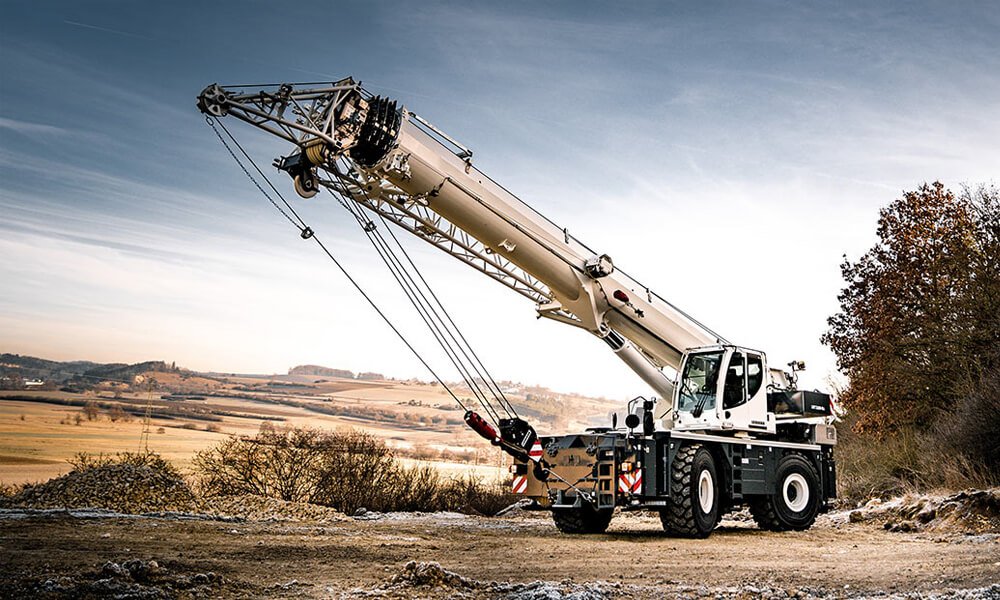Cranes are one of the real workhorses of the building and construction industry and they can be deployed for numerous other uses as well, such as salvage operations, removing crashed cars from rivers and lakes and many other practical applications.
While there are many models of cranes out there, designed for certain purposes, this article is going to be focusing on two types of cranes:
Rough-Terrain Cranes
All-Terrain Cranes
We’ll be taking a closer look at the roles of each of these cranes and what the key differences are between the two. While they may share some similar characteristics and can perform similar job roles, rough-terrain cranes and all-terrain cranes are not identical.
Rough-Terrain Cranes
For certain applications, cranes that are mounted onto a vehicle are not always suitable for extremely rough terrain. This is where the rough-terrain crane comes into play. They have been designed for off-site and off-road applications and have extremely robust and sturdy build quality.
Rough-terrain cranes come in different varieties. Some are transported to the site and mounted on uneven ground, being stabilised by either resting on four rubber tyres spread wide apart for a stable centre of gravity, or they’ll have tracks similar to a tractor. Outriggers (or metal legs and feet) are extended to give the crane rigidity and stability for safe use.
Generally, the undercarriage and the crane are operated by the one engine in a rough-terrain crane. It’s also important to note that a true rough-terrain crane cannot be driven on regular roads and therefore has to be transported to its location.
Some of the positives of rough terrain cranes are their incredible stability on uneven surfaces. This is largely due to their wide centre of gravity. All-wheel drive and power steering help make life so much easier for the crane operator. They also have quite enhanced off-road mobility, allowing the crane to be positioned exactly where it needs to be.
Some disadvantages of rough-terrain cranes are some models have a reduced lifting capacity, they can’t be driven on public roads and they usually need outriggers to keep them stabilised.
All-Terrain Cranes
Let’s now see what the all-terrain crane is all about.
This type of crane comes mounted on a vehicle that is allowed to drive on public roads. The all-terrain crane is also suitable for rough off-road conditions, though not quite as effective as the rough-terrain crane. All-terrain cranes tend to have more wheels than the rough-terrain model and either come in four-wheel drive or all-wheel drive. This type of crane is generally larger than a rough-terrain crane.
Many all-terrain cranes come with telescopic booms, where the length of the boom can be adjusted for more height and leverage or lowered if need be. These cranes are extremely powerful and can lift heavy loads, but often lack the stability provided by a rough-terrain crane on very uneven surfaces. Having said that, all-terrain cranes (as the name suggests) are extremely versatile and can negotiate all manner of surfaces; just so long as the terrain is not too rough for its capabilities.
Some of the positives of the all-terrain crane include its ability to be driven to the site via public roads and its capacity to lift very heavy loads. This type of crane is also highly manoeuvrable and can navigate many different types of surfaces with relative ease. Highly adjustable booms are also a distinct advantage of the all-terrain crane.
Some disadvantages of the all-terrain crane are that they are not suitable for all types of terrain. They also tend to be very heavy cranes and can sometimes need outriggers to keep them stable enough to operate with safety.
The Wrap
When considering crane hire, which type of crane is right for you?
Now that you have a clearer picture of both the similarities and differences between the rough-terrain crane and the all-terrain crane, you’ll get a better idea of which type of crane you will need to successfully get your project done.
If you need a crane that can travel on its own to the job site, you’ll want to choose an all-terrain crane. However, if the ground is simply too uneven or rugged, you will need to deploy a rough-terrain crane to get the job done.
